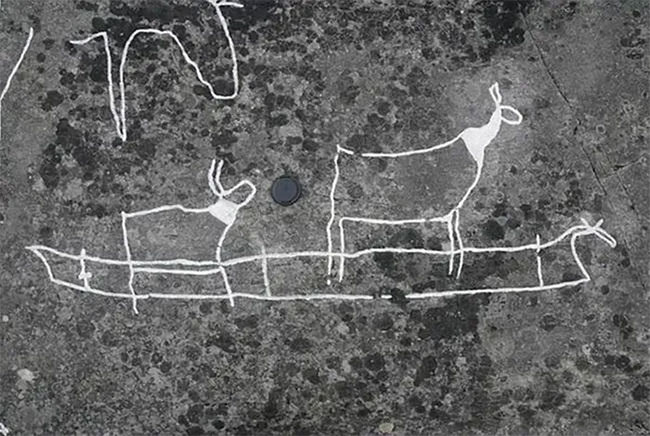Did Scandinavians use boats made of animal skins 5,000 years ago?
Ancient Scandinavians may have used boats made from animal skins for fishing, hunting and transporting trade goods, a new study suggests.
According to research just published in the Journal of Maritime Archaeology, the Neolithic hunter-gatherer group known as the Pottery Culture (PWC) , who lived in Scandinavia from 3500 to 2300 BC, is perhaps best known for its pottery, which featured flat-bottomed jars. They were also adept hunters, especially seal hunters.

Rock art depicting two deer being transported by boat. (Photo: Martin Kristoffer Hykkerud and Verdensarvsenter).
Archaeologists believe that PWC may have used the skins of aquatic animals to build their ships , as well as oil from seal blubber to help maintain their boats.
'We know that these people hunted a lot of seals, as evidenced by the large number of seal bones found at the sites where they lived,' said study lead author Mikael Fauvelle, a researcher at the Department of Archaeology and Ancient History at Lund University in Sweden.
' Seals are also one of the most suitable animals for boat building , as the Inuit [an indigenous group living in Canada, Greenland and Alaska] used seal blubber to waterproof their boats. We know that PWC had large amounts of seal blubber, which can be found in their pottery (at archaeological sites),' he added.
Researchers analyzed the inside of some of the jars and found traces of lipid residue from seal blubber, Fauvelle added. The PWC is a culture that relied on fishing because it lived in an area surrounded by large bodies of water, including the Baltic and North Seas.
'They moved around a lot and traded with other groups regularly,' Fauvelle said. 'They were out in the ocean, moving across large bodies of water.'
Researchers suggest that more primitive boats, such as canoes made from hollow logs, would be inefficient for traveling hundreds of miles across open seas. Boats made from sealskin would be sturdier.
In fact, according to research, the boats — depending on size — could be large enough to carry about a dozen people at a time, as well as animals, including deer, bears, and cattle.
However, the researchers admit that they have found little physical evidence of these boats, apart from a few small fragments discovered over the years at sites across northern Sweden that the researchers say may be direct evidence of Neolithic leather boat use.
The paintings, along with possible fragments of boat frames, are evidence that the PWC people were superior boat builders, knowledgeable about "nautical technology" and used "advanced vessels" to travel between different islands.
- Video: Paper boat can carry people floating on the lake
- Whales do not know how to avoid boats
- Detecting bronze artifacts intact
- New explanation for boats disappearing in the Bermuda triangle
- Discover 12 ancient boats on the bottom of the Baltic Sea
- Straws made from mango peelings are biodegradable
- Waterspout swept away ships and boats in Khanh Hoa sea
- Experimenting 'ghost boat' startles you
- The ship brought Egyptian pharaohs to the afterlife
- Flowers made from animal bones
- 4m long tiger shark overturned the boat, attacking people in Australia
- Stanford scientists have successfully built batteries made from fertilizer and animal waste, which are extremely cheap
 Discovered an ancient centipede fossil 99 million years old
Discovered an ancient centipede fossil 99 million years old Discovered bat-like dinosaurs in China
Discovered bat-like dinosaurs in China Discovered a 200-year-old bronze cannon of the coast
Discovered a 200-year-old bronze cannon of the coast Discover 305 million-year-old spider fossils
Discover 305 million-year-old spider fossils